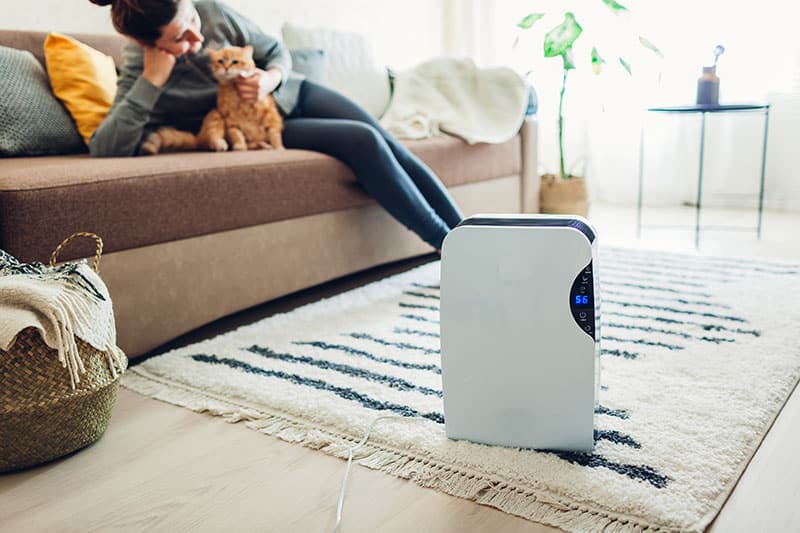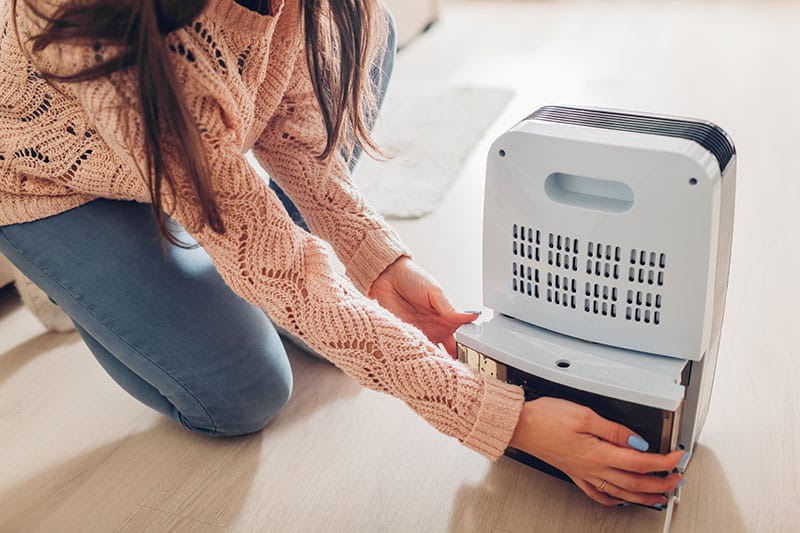There’s nothing more refreshing than the crisp air of a humidity-free home.
But just how long should you run your dehumidifier every day? Check out this article to see!
You should run a dehumidifier for 12 hours everyday. This will allow it to be the most efficient, letting it constantly remove moisture without running up a huge energy bill. The time to run a dehumidifier varies on the starting humidity level, the target level, and the power of the dehumidifier.
You may be wondering, what do the starting and target humidity levels have to do with the runtime?
And, where does the size of the dehumidifier factor in on all this?
Make sure you have a look at the rest of this article as it will answer these questions. It will help you to figure out an ideal dehumidifier runtime for your home.
How Long Should You Run a Dehumidifier?
Have you purchased a dehumidifier recently? Then you will more than likely agree that the results are sensational. You can really feel the difference in the air quality when coming from outside to inside. They are great at removing the uncomfortable humidity from the air. But most importantly, they help to reduce some of the following pesky problems:
- Mold
- Mildew
- Dampness
- Condensation
- Odors
Now dehumidifiers are fantastic, but they can be kind of expensive to buy and even pricier to run. So, what can you do to get the most benefit out of your dehumidifier without racking up a hefty electric bill?
Running a dehumidifier is all about timing. You can keep your home at an ideal humidity level by running your dehumidifier for as little as 12 hours a day. But, of course, this does all depend on a few external factors. Take a look at some of them below.
The Target Humidity Level
What humidity level are you aiming for in your home? If your home is at a humidity level lower than 60% then it is more likely to remain free from damp and mold. For a healthy, comfortable home, you should keep it between 40 and 55% humidity.
Whether you like your home closer to the 40% or 55% level of humidity will affect the dehumidifier’s runtime. Is your dehumidifier set to shut off when your room reaches 40% humidity? Then it will need to run for longer than if it were set to shut off at 55% humidity.

The Starting Humidity Level
The starting humidity level in your home will also affect the runtime of your dehumidifier. If your home is humid or the weather outside is warm, it will need to run for longer.
You may have high humidity levels in your home if any of the following can be found:
- Cracks in the windows and doors
- Gas heating
- Inadequate ventilation in the bathroom
- Leaks in pipes or the roof
Certain rooms in the home are more humid than others. Here is a list of the most humid rooms in the house:
- The bathroom. Due to the many water sources.
- The kitchen. Due to the many water sources.
- The laundry room. Or anywhere you hang damp laundry.
The Size of the Dehumidifier
The size of your dehumidifier will also affect its runtime. Do you have a small dehumidifier working in a large room? Then it will take longer for it to get the air to optimal humidity levels. It will dehumidify a room a lot quicker if all the windows and doors are closed.
The capacity of your dehumidifier is also important. A powerful dehumidifier can get your home to comfortable humidity levels fast.

How to Reduce the Runtime of a Dehumidifier
So far we’ve spoken a lot about the things that increase the runtime of a dehumidifier. So, what can you do to reduce its runtime and avoid burning a hole in your wallet? Take a look at the following information. It will provide you with great tips to reduce humidity in many different places in the home.
| Room | How You Can Reduce the Humidity |
| The Bathroom | -Fix any leaking pipes. -Keep the windows and doors shut and sealed. -Install an extractor fan. The fan should run for at least 10 minutes after you use the bath or the shower. |
| The Kitchen | -Fix any leaking pipes. -Keep the windows and doors shut and sealed. -Install an extractor fan hood. Use the hood while cooking. Keep it running until the moisture has cleared from the air after cooking. |
| The Bedroom | -Keep windows and doors shut and sealed. |
| The Utility Room | -Make sure the tumble dryer is vented properly outside. This will prevent warm, moist air from being vented inside. |
| The Drying Room | -Install a vent fan. |
| The Basement | -Fix any leaking pipes. -Cover over the vents. -Caulk and seal all pipe openings even if they exit underground. |
| The Attic | -Fix any leaking roof tiles. |
How Quickly Should a Dehumidifier Fill Up?
You should empty the water bucket in the dehumidifier periodically. This will help the dehumidifier to work more efficiently. Have you just bought a brand new dehumidifier? Then you may be wondering how long it will take on average for the bucket to fill up.
It usually takes a dehumidifier between 6 and 7 hours to fill up. But the time it takes to fill up is dependent on a few factors. Here are some of them:
- The target humidity level
- The starting humidity level
- The size of the dehumidifier
Let’s consider some of these factors in a little more detail.
The Target Humidity Level
The recommended, comfortable humidity level for a home is between 40 and 55%. What humidity level is your dehumidifier set to? If it is set to a lower humidity level (closer to 40%) then the dehumidifier will have to work harder. It will take longer for the room to reach its target level. This will make the water bucket fill up faster.
But, if your dehumidifier is set to a higher humidity level (closer to 55%) then it will not have to work quite so hard. It will not take as long for the room to reach its target humidity level. This will make the water bucket fill up slower.

The Starting Humidity Level
The humidity level in your home will also affect how quickly the bucket fills. If your home is more humid, then the dehumidifier will have to work harder. It will take longer for the room to dehumidify. This will make the bucket fill up faster.
But if your home is not very humid and the weather outside is cool, the bucket will not fill up as quickly.
The Size of the Dehumidifier
The size of the dehumidifier will also affect how quickly the bucket fills. Every dehumidifier has different specifications and a different sized water bucket. If you have a small unit and a big room to dehumidify, then it will fill up quickly.
If you have a larger sized dehumidifier and an average-sized room then the bucket should fill up every 6 to 7 hours.
Is It Safe to Leave a Dehumidifier on All Night?
It is safe to leave a dehumidifier on all night. In fact, it is recommended that you do so if you suffer from allergies or any of the following:
- Hay Fever
- Sneezing
- Itchy eyes
- Sinusitis
- Coughing
- Asthma
Why is it good to sleep with the dehumidifier on? Allergy triggers such as mold and dust mites thrive in humidity. So, if you reduce the humidity in the room, you will be lowering the allergen count in the room. This could help you to breathe easier at night and help you get a better start to each day.
What can you do if you’re still not keen on the idea of sleeping with the dehumidifier on all night? Then set the unit to switch off after the room has reached a certain humidity level. Keep your windows and doors shut while you sleep. This way the dehumidifier will not need to work so hard to keep the humidity levels optimal. This will reduce its runtime.
Conclusion
We all like the feeling of crisp, dehumidified air. But, it could be expensive for you to run your dehumidifier 24/7. I hope this article has given you an idea of some ideal runtimes for your dehumidifier that suit your circumstances.
If this article has helped you, then why not check out some of our other articles and free guides? You could even sign up to our email list!
Have a great day!
-Craig







